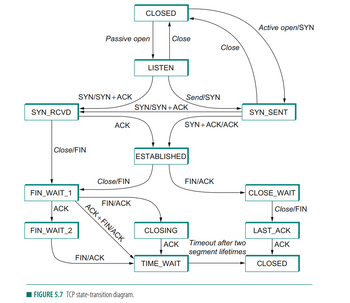
This chapter explains three sequences of state transitions during TCP connection teardown. There is a fourth possible sequence, which traverses an additional arc (not shown in Figure 5.7) from FIN_WAIT_1 to TIME_WAIT and labeled FIN+ACK/ACK. Explain the circumstances that result in this fourth teardown sequence.
Notes from the book to help: There is actually a fourth, although rare, sequence of transitions that leads to the CLOSED state; it follows the arc from FIN WAIT 1 to TIME WAIT. We leave it as an exercise for you to figure out what combination of circumstances leads to this fourth possibility. The main thing to recognize about connection teardown is that a connection in the TIME WAIT state cannot move to the CLOSED state until it has waited for two times the maximum amount of time an IP datagram might live in the Internet (i.e., 120 seconds). The reason for this is that, while the local side of the connection has sent an ACK in response to the other side’s FIN segment, it does not know that the ACK was successfully delivered. As a consequence, the other side might retransmit its FIN segment, and this second FIN segment might be delayed in the network. If the connection were allowed to move directly to the CLOSED state, then another pair of application processes might come along and open the same connection (i.e., use the same pair of port numbers), and the delayed FIN segment from the earlier incarnation of the connection would immediately initiate the termination of the later incarnation of that connection.

Trending nowThis is a popular solution!
Step by stepSolved in 3 steps

- So, what may happen to a message when it is transmitted over an unstable TCP connection, and what strategies are used to cope with such problems?arrow_forwardUnder what circumstances may coarse-grained timeouts still occur in TCP even when the fast retransmit mechanism is being used?arrow_forwardDoes this make sense to you, or do you believe it to be incorrect? Consider the most recent SampleRTT on a TCP connection to be one second. In order for the connection to be deemed active and functioning, the current TimeoutInterval value must be greater than one second.arrow_forward
- TCP is a sliding window protocol. This means. а. there can be more than one segment "in flight" (sent but no ACK has been received) at a time. O b. the TCP retransmission timer slides up as ACKS are received. O c. there can only be one segment outstanding (sent but no ACK has been received) at at time.arrow_forwardThere are two perspectives to consider. It is assumed that the most recent SampleRTT on a TCP connection is 1 second. To keep the current connection open, TimeoutInterval has to be larger than or equal to one second.arrow_forwardIf there is wide variation in the TCP segment size , it is natural to organize the buffers as a pool of fixed-sized buffers, with one segment per buffer TRUE OR FALSEarrow_forward
- 199arrow_forwardAssume that a bottleneck connection with a rate of R bps carries two TCP connections. In both cases, there is a big file that must be downloaded (in the same direction over the bottleneck link). The files are all transmitted at the same time How much data will TCP be able to transmit each connection?arrow_forwardConsider a TCP connection with the following parameters: a) Initial ssthreshold = 8 b) Round Trip Time (RTT) = 10 milliseconds c) Retransmission Timeout period = 40 milliseconds d) Segment size = 2700 bytes The TCP connection was used to transfer 19 data segments, numbered 1 through 19. While sending the segments, data segment 10 was lost the first time it was sent (but arrived at the receiver properly upon being retransmitted). There were no other segment losses apart from the aforementioned. Assume that data segments received out-of-order are buffered at the receiver. What is the average throughput obtained in sending all the data segments (in bytes/sec)? Draw a diagram to show the transmission of the segments in detail.arrow_forward
- Is it the case or not? Let's pretend the most recent SampleRTT on your TCP connection was 1 second. The connection will time out if the TimeoutInterval is less than one second.arrow_forwardIs this an accurate or wrong statement? For simplicity, let us assume that the most recent SampleRTT on a TCP connection is one second. The current TimeoutInterval value for the connection must be greater than one second in order to maintain the connection.arrow_forwardIs this the right answer or the wrong answer? Assume that the most recent SampleRTT for a TCP connection is one second. The TimeoutInterval setting for the connection must now be set to a value that is greater than one second.arrow_forward
 Database System ConceptsComputer ScienceISBN:9780078022159Author:Abraham Silberschatz Professor, Henry F. Korth, S. SudarshanPublisher:McGraw-Hill Education
Database System ConceptsComputer ScienceISBN:9780078022159Author:Abraham Silberschatz Professor, Henry F. Korth, S. SudarshanPublisher:McGraw-Hill Education Starting Out with Python (4th Edition)Computer ScienceISBN:9780134444321Author:Tony GaddisPublisher:PEARSON
Starting Out with Python (4th Edition)Computer ScienceISBN:9780134444321Author:Tony GaddisPublisher:PEARSON Digital Fundamentals (11th Edition)Computer ScienceISBN:9780132737968Author:Thomas L. FloydPublisher:PEARSON
Digital Fundamentals (11th Edition)Computer ScienceISBN:9780132737968Author:Thomas L. FloydPublisher:PEARSON C How to Program (8th Edition)Computer ScienceISBN:9780133976892Author:Paul J. Deitel, Harvey DeitelPublisher:PEARSON
C How to Program (8th Edition)Computer ScienceISBN:9780133976892Author:Paul J. Deitel, Harvey DeitelPublisher:PEARSON Database Systems: Design, Implementation, & Manag...Computer ScienceISBN:9781337627900Author:Carlos Coronel, Steven MorrisPublisher:Cengage Learning
Database Systems: Design, Implementation, & Manag...Computer ScienceISBN:9781337627900Author:Carlos Coronel, Steven MorrisPublisher:Cengage Learning Programmable Logic ControllersComputer ScienceISBN:9780073373843Author:Frank D. PetruzellaPublisher:McGraw-Hill Education
Programmable Logic ControllersComputer ScienceISBN:9780073373843Author:Frank D. PetruzellaPublisher:McGraw-Hill Education





